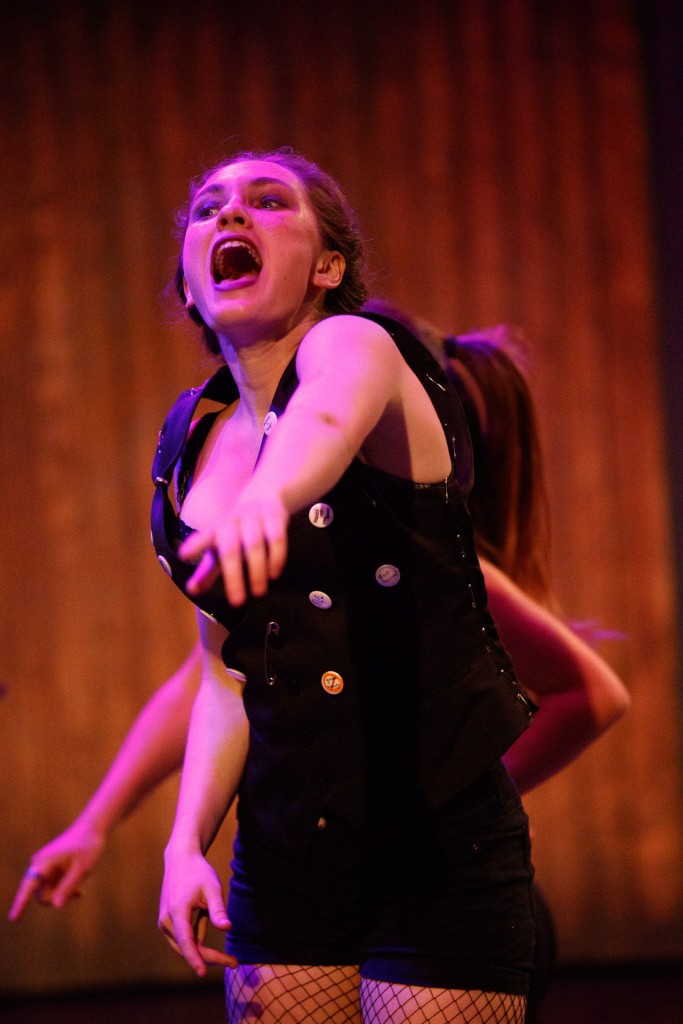A multi-color-mohawked girl stooped down to me, offering from her utility belt colored barrettes, tampons, and a zine. “Have you heard of the Riot grrl movement?” she asked. “The movement showed that you can be feminine and angry- that those two things are not mutually exclusive.” With this, the cast members engaged with the audience to set the scene before the show had even started.
Saint Joan of the Stockyards, which emerged as Lillian Bornstein’s (as Pierpont Mauler, ’17) senior project, utilized the Riot grrl movement’s energy and punk aesthetic as a canvas for TAPS’ production. Written by Bertolt Brecht in 1931, the play rewrites the story of Joan of Arc and sets it within the meat-packing industry of Chicago to address issues of religion, socialism, capitalism, and class. Bornstein and director Jessi Piggott’s decision to use Riot grrl as a framework for the performance was an ambitious decision to elevate the experience as one that questions the sociopolitical.
Riot grrl was an underground, feminist punk-rock movement that originated in the ’90’s. Bands of women used music to empower and to organize, with the goal of ending social and political oppression. As such, the cast was all-female, and featured live, original punk music (Dylan Grosz on bass, Megha Makam on drums and vocals, and Sera Park on guitar). The set, costumes, and music drew the audience into a rapturous punk-rock world, while the script of the actual play was in juxtaposition to the chosen design. It collided the gendered power-play of the script with the fact of its all-female cast, forcing the audience to consider how the play’s themes of capitalist injustices intersect with issues of feminism or gender. As Bornstein noted in the program-zine, interpolating the Riot grrl movement with the class struggles of 20th century Chicago with an all-female cast evoked “the constant question of messing with systems and categories and reforming them but still upholding them, versus dismantling/abolishing them completely.”
As implied by Bornstein’s description, the production was treated as a means of exploring the political through art, and it felt that way. Thus, the simultaneous strength and fault of the production was that everything was symbolic in nature, as a result of both the script and production’s take. The script itself was not crucial because what mattered more were the symbolic roles each character played: Mauler, who represented the struggle between individuality and accountability; Saint Joan, who finds the difficulty in living virtuously in a world defined by capitalist hierarchies; and other characters, who represented the faults of economic and religious institutions.
Brecht’s script, which relies on symbolism, is more reliant on the movement of its characters throughout its plot rather than on its language. In effect, the dialogue either felt bogged down by economic vocabulary to describe the rise and fall of the stock market or hyperbolic whenever symbolic characters had significant moments, rather than on emotional nuance. The actors were notably committed, but each was limited to treating their characters as a caricature since the symbolism superseded the personal in this play. Their portrayals were thus constantly exaggerated and in forte, lacking intimacy. Which is perhaps what the play demands, as a political statement, but not one that is necessarily as personally impressive or moving.
The production of Saint Joan of the Stockyards left the audience thinking about the intersectionality of feminist and capitalist issues and their relevancy. Treating performance as an intellectual exploration of gendered, capitalist systems is certainly provocative, but not emotionally fulfilling or moving. Which, as expected, is what happens when the political supersedes the personal.
photos courtesy of Frank Chen


